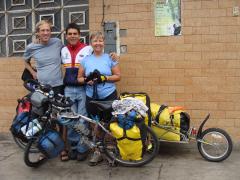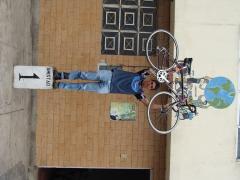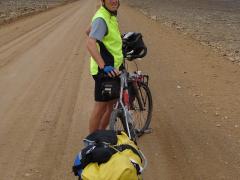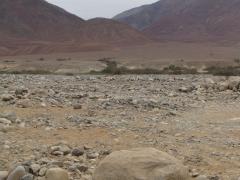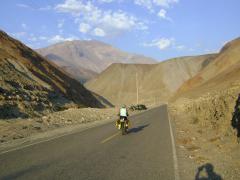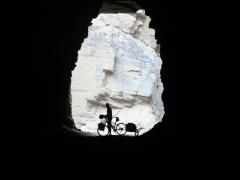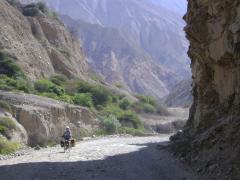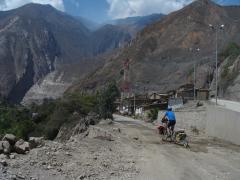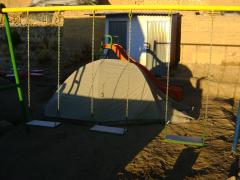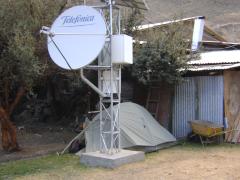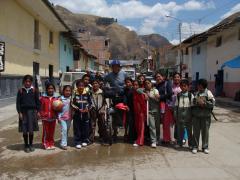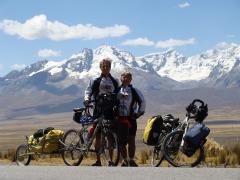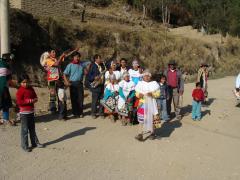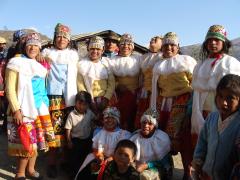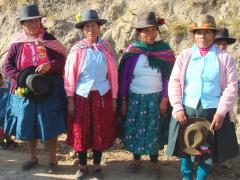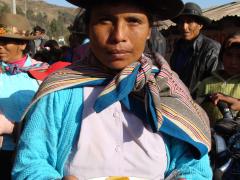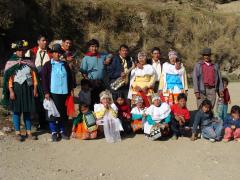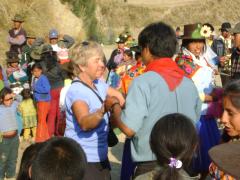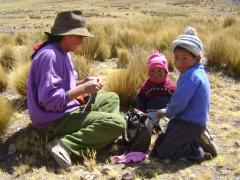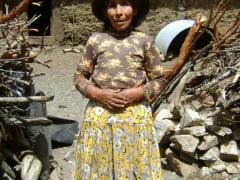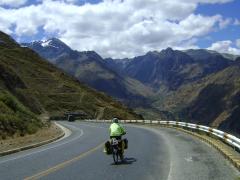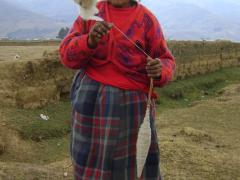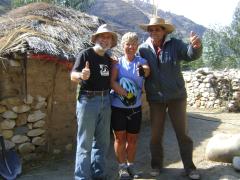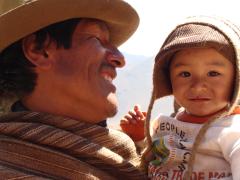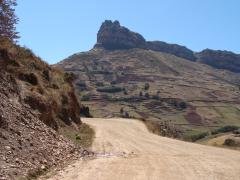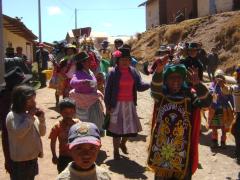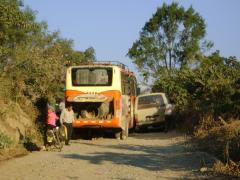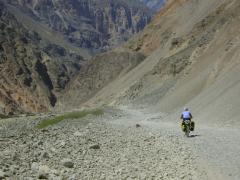Trip Blog
Bike Maintenance Log
Several of you bike touring people have asked us about bike maintenance and the problems we've had, so we decided to put together a log.
July 2006: Cassiar Highway. Broken spoke and wobbly wheel on Randy's drive side of rear wheel. We broke the Hyper-Cracker tool (that takes the cassette off) in a hailstorm trying to use it. Took us 300 miles to get to a place with a tool to take it off, but we made it.
September 2006: New tires in Victoria, BC.
October 2006: California: Spoke nipple broke through rim on Randy's rear wheel. Got a new wheel built, hoping for the best.
January 2007: New bottom bracket for Randy's bike. New drive train, cables, housing, tires (Continental TravelContact), touring handlebars, many other things before starting out. We also had to buy a replacement set of Old Man Mountain racks for Randy's bike because the 5000 miles of the trip so far had created big abrasions in the (aluminum) racks. Old Man Mountain gave us the new racks at cost.
February 2007: Randy's new rear wheel (from California) failed in Tucson. It was a fancy downhill rim, too. We'll never use another Mavic rim of any type for bike touring.
April 2007: Randy gave up on the fancy Brooks saddle (never did get comfortable) and got a new one, Terry touring saddle that seems to be OK.
May 2007: New chains and cassettes on Oaxaca, Mexico.
January 2008: New chains in Guatemala.
January 2008: Nancy's seatpost clamp failed in Honduras. A good little back-alley bike mechanic used the remaining parts to build something that carried us through to Tegucigalpa, where we were able to get a good seatpost clamp.
April 2008: New drivetrain and new Continental TravelContact tires in Panama City. We've been using these since Arizona and like them a lot, but they don't last for as many miles as we'd like.
May 2008: Randy's rear rim finally got to failure in Colombia (had been threatening since Guatemala). Wheel rebuild with an AlexRims rim cost a total of US$25. Hope it holds up!
June 2008: Nancy gave up on her Brooks Saddle in Quito and went with the Terry saddle. Never quite got comfortable.
July 2008: Randy's Old Man Mountain racks are again (Cuenca, Ecuador) showing amazing signs of wear. On closer inspection, we find that the abrasion has broken all the way through to the inside of the tube. A trip to a welder ought to fix it... but the day after the welder touched it the tube broke. Now it's held together with pipe clamps.
August 2008: New racks on both bikes, provided per warranty by Old Man Mountain. Randy switches to the BOB trailer after the rack abrasion and break problem. Note that Old Man Mountain was kind enough to replace our worn racks for free and without complaint.
August 2008: Both bikes get a full going over by Lucho in Trujillo, with bearings lubed, wheels trued, etc. Nancy gets a new Vuelta rear rim on her back wheel in Huaraz, as the old rim was getting quite worn. (It's not nearly as hard to get a wheel build here as in the US. You go into a shop. If they have a rim you can live with they build it for you, in an hour or so. And charge maybe $5 for the build.) But Randy removes the rear rack to install the BOB trailer.
September 2008: Got rear axle cones adjusted in Ayacucho, Peru, as they were a bit loose.
September 2008: New Continental TravelContact tires installed in Cuzco, Peru. (We had brought them back with us to Trujillo, Peru and mailed them to the South American Explorers Club in Cuzco).
October 2008: Full maintenance of our Fox front shocks in La Paz, Bolivia. Nancy's had ceased to hold air. Gravity Assisted Mountain Biking has an incredible shop and lots of parts and support, and English-speakers. An amazing shop, the fanciest we've seen in Latin America. Highly recommended. You can contact them in advance by email if you need them to obtain parts.
Una pequeña viaje hacia casa para ver a nuestra familia
Acabamos de llegar a Perú venidos de una estorbada viaje a Estados Unidos. Fue excelente y exhaustiva. Primero, tuvimos que enfrentar 10 horas de autobús para la cuesta de la Cajamarca, entonces más 8 horas de autobús de Trujillo a la capital de Perú, Lima. Entonces volamos por mucho tiempo hacia Boston, y llegamos a tiempo para el evento principal que apretaba nuestro viaje: el cumpleaños de 80 años del padre de Nancy, Frank Lewis. Fuimos para la cabaña del hermano de Nancy, Dan, en New Hampshire y vivimos una conmemoración deliciosa.
Entonces volamos hacia Denver para ver los hijos de Randy, Elisheba y Mark, y dirigimos hasta Grand Junction, Colorado, para ver los padres de Randy. Caminamos con ellos a vemos su nuevo lar en el retiro de edad Atrium, en Grand Junction – ellos tienen una linda cabaña, completa, incluso con más espacio del que tenían antes, garaje, y el confort de hacer las comidas en el propio retiro. Instalaciones muy buenas.
Entonces dirigimos de vuelta a Denver y tuvimos un encuentro con amigos que fue un encanto absoluto. Varios amigos vinieron a vernos, incluso un grupo de ciclistas viajeros que no conocíamos, Nick y Dave, dos impresionantes jóvenes que están para partir de Denver en el camino de Panamá. ¡Gracias a todos qué vinieron y también a los qué no pudieron venir por su amistad! ¡Gracias, Ann, por la deliciosa recepción de la fiesta!
Los últimos días fueron gastos en una tentativa frenética de organizar todo el equipo que queríamos llevar con nosotros (cosas más calientes para las montañas, cosas nuevas que encargamos y compramos, etc.) Fue increíblemente estresante para mí, especialmente cuando decidí llevar mi trailer BOB conmigo al revés de continuar usando alforges (historia por venir). El cambio representaba un pequeño riesgo, una vez que no usaba el trailer desde 2004 y él estaba abandonado en un canto del garaje de Elisheba. Estaba realmente con miedo de haber olvidado un algo que me impediese de usarlo, o que no me adaptaría, o que un algo se perdería en el viaje de avión que estorbase todo...no se ponía tan ansioso hace años. De cualquier forma, logramos empacar todo eso, embarcar en el avión, y traer de vuelta a Lima, viajar las 9 horas de autobús para Trujillo, y tener todo instalado en la Casa de Ciclistas nuevamente. (Todo funcionó, y estoy contento pilotando con el trailer. Escribiré más sobre eso después.)
Lucho y la Casa de Ciclistas en Trujillo, Peru
Cuando bajamos de las montañas de Perú para la costa, nos quedamos en la legendaria Casa de Ciclistas en Trujillo, Perú. Lucho Ramirez empezó ofrecer su modesta casa para ciclistas viajeros ya en 1984, y él está a un paso de completar la marca de mil huéspedes. ¡Mil grupos de ciclistas firmaron su diario y se quedaron allá a lo largo de 25 años! ¡Un ciclista se quedó un año! Muchos se quedaron por bien más tiempo del que esperaban, frecuentemente por una semana o más. Es un encanto hojear las páginas del diario y ver ciclistas famosos que nosotros conocemos u oímos decir que pasaron por aquí. Nuestros amigos Dick y Els, de Holanda, firmaron el libro cerca de 5 años atrás. Nuestro amigo Andrew lo firmó hay solamente un mes y poco. Nuestros amigos Pat y Cat también pasaron por aquí cerca de 3 años atrás.
Muchos de ustedes nos preguntaron si estábamos intentando quebrar alguno récord o cosa parecida, y la respuesta es no, vamos realmente bien despacio, y muchas y muchas personas fueron más lejos. Aunque ni todos los ciclistas que pararon en la casa de Lucho estuviesen haciendo viajes grandes como nuestra, muchos estaban haciendo muy mayores. Un compañero, Hans Stuecke, ¡ha pedaleado por 46 años!
Comoquiera Lucho ofrece un lugar extremadamente amigable para ciclistas paren, recarguen, tienen su equipo revisado, y generalmente tienen un recuerdo maravilloso. Dejamos nuestras bicicletas en seguridad allá durante nustra viaje hacia casa, y volvemos a encontrarlas esperándonos. Lucho también trabajó la noche toda para dejar nuestras bicicletas en orden y perfectos (es mecánico de bicicletas profesional). Y él tiene informaciones sobre todas las rutas, y sabe cuales lugares evitar debido a que ataques criminosos a ciclistas.
Lucho es también un increíble promotor del ciclismo en su ciudad. Organiza carreras de ciclismo para niños y adultos (ayudamos en una) y él mismo es corredor – él suele ser campeón en la área. Su hijo se llama Lance, si eso te da una pista.
¡Gracias, Lucho! Es famoso, y su fama es bien merecida.
Nota: Lucho tiene la Casa de Ciclistas original de Latinoamerica, pero él también inspiró otras. Nosotros nos quedamos en una en Cali, Colombia.
Aquí están algunos enlaces:
- Sitio de Lucho sobre la Casa de Ciclistas en Trujillo
- Lista de Casas de Ciclistas en Latinoamerica
- Nuestra visita a Casa de Cali, Colombia
- No se olvide de Warmshowers.org, el sitio de hospitalidad de lo cual Randy es webmaster. Personas de todo el mundo ofrecen hospitalidad a ciclistas viajeros a través de Warmshowers.
A quick trip home to see our family
We just got back to Peru from a whirlwind trip back to the US. It was great, and exhausting. First, we had to take a 10-hour bus down to the coast from Cajamarca, then an 8-hour bus from Trujillo to the capital of Peru, Lima. Then we flew for ages to Boston, and we arrived in time for the main event that timed our trip: The 80th birthday celebration of Nancy's dad, Frank Lewis. We went to her brother Dan's cabin in New Hampshire and had a delightful celebration.
Then we flew to Denver and got to see Randy's kids, Elisheba and Mark, and drove to Grand Junction, Colorado to see Randy's parents. We got to walk with them and see their new home at the Atrium living center in Grand Junction - they have a beautiful cottage, complete with even more space than they had before, a garage, and a meal a day at the nice facility next door. Very good setup.
Then we drove back to Denver and had a get-together with friends which was an absolute delight. Several friends came to say hello, and even one set of bike tourists we'd never met, Nick and Dave, two impressive young men who are about to set off from Denver on their way to Panama. Thanks to all of you who came and who couldn't for your friendship! Thanks, Ann, for the delightful hosting of the party!
The last couple of days were spent frantically trying to arrange all the gear we wanted to take back with us (warmer stuff for the mountains, new stuff we'd ordered and bought, etc.) It was incredibly stressful for me, especially when I decided to take my BOB trailer back with me instead of continuing using panniers (story to come). The change was a little risky, as I hadn't used the BOB since 2004 and it's been sitting lonely in a corner of Elisheba's garage. I was really afraid that I'd forget something that would make it unusable, or that it really wouldn't suit me, or that something would get lost in the airplane ride that would mess it all up... I haven't been so anxious in years. Anyway, we got it all packed up, got on the plane, and made it back to Lima, took the 9-hour bus back to Trujillo, and got all set up at the Casa de Ciclistas again. (It all worked, and I'm happily riding with the BOB trailer. I'll write more about that later.)
Lucho and the Casa de Ciclistas in Trujillo, Peru
When we came down from the mountains of Peru to the coast we stayed at the fabled Casa de Ciclistas (House of Cyclists) in Trujillo, Peru. Lucho Ramirez started offering his simple house to passing touring cyclists clear back in 1984, and is on the edge of crossing the one thousand mark. One thousand groups of cyclists have signed his journal and stayed there over almost 25 years! One cyclist stayed a year! Many stay far longer than they expect to, often for a week or more. It's a delight to browse through the journals and see famous cyclists that we've either met or heard of who passed this way. Our friends Dick and Els, from Holland, signed the book about 5 years ago. Our friend Andrew signed it just a month or so ago. Our friends Pat and Cat also passed through about 3 years ago.
Many of you have asked us if we're setting some kind of a record or something, and the answer is no, we're really slow, and lots and lots of people have gone farther. Although not all the cyclists who have stopped at Lucho's house were doing rides as big as ours, many were doing rides much bigger. One fellow, Hans Stuecke, has been cycling for 46 years!
Anyway, Lucho provides a tremendously friendly place for cyclists stop, recharge, get their equipment worked on, and generally have a wonderful memory. We left our bikes safely there for our trip home, and came back to find them waiting for us. Lucho also worked all night to get our bikes maintained and in tip-top shape (he's a professional bike mechanic). And he has info on all the routes, and knows what places to avoid due to criminal attacks on cyclists.
Lucho is also an incredible promoter of cycling in his town. He organizes bike races for kids and adults (we helped with one) and is also a racer himself - he used to be the champion of the area. His young son is named Lance, if that gives you a clue.
Thank you Lucho! You're famous, and your fame is well-deserved.
Note: Lucho has the original Casa de Ciclistas in Latin America, but he has also inspired others. We stayed at one in Cali, Colombia.
Here are some links:
- Lucho's website about the Casa de Ciclistas in Trujillo
- The list of Casas de Ciclistas in Latin America
- Our visit to the Casa in Cali, Colombia
- Don't forget about Warmshowers.org, the hospitality site of which Randy is webmaster. People all over the world offer hospitality to touring cyclists through Warm Showers.
Cyclists before us at the Casa de Ciclistas
People often ask us "Has anyone ever done this before?" or "Are you setting a new Guinness Record?". The answer, of course, is an authoritative NO! We know this, of course, but stopping at the Casa de Ciclistas in Trujillo and looking through the logs makes us really feel humble. We were the 998th entry over 24 years. Plenty of people have been through here! There are slow people and fast, many rides as long as ours, but many much longer. Here are a few links and a few details about some of the folks who have signed their names in the logs at Trujillo.
- Hans Stuecke
- Hans has been bike touring for 46 years, and has visited at least 193 countries. He really HAS set a Guinness record. I don't think we're going to touch his record anytime soon!
- Dominic Gill
- Dominic started his ride about the same time as we did, and we actually met him for a few moments in Whitehorse, Yukon Territory. But Dominic just finished riding a tandem (most of the time by himself, alone) with gear for himself and a guest, all the way from Alaska to Patagonia. His gear weight was incredible, but his idea was "Take a Seat". He invited anybody who wanted to to come along for a ride for as long as they wanted. He had incredible experiences.
- The Ciclonautas
- We met Andrei and Dulce (and not Fernando), the "Ciclonautas" in Queretaro, Mexico, but they passed through the Casa de Ciclistas several years ago. As young Mexicans with very limited resources, they set off on a journey all the way from their home city to the bottom of South America, Ushuaia, where we're going too, and they made it. They worked along the way, getting a tiny sponsorship in Honduras, but mostly just working at their trades in each city until they had enough to continue. And they made it all the way, on no money.
- Andrew Morgan
- We met Andrew on our yacht trip from Panama to Colombia. (There were 5 of us cyclists on that boat! Pius and Stefan were on it too). Andrew is teaching everywhere he goes, and working with teachers and students around the world via his website.
- Pius and Stefan
- Pius and Stefan are the blazing fast guys on the recumbent bikes WAY ahead of us. They're young and full of vim and vigor. They race each other between cities and go farther in a day than we go in three. And they're great people.
- Pat and Cat Patterson
- Pat and Cat hosted us when we were going south through California and they had just gotten home from four years riding around the world (North America, Europe, Africa, and South America back up to California). They're even older than we are, if you can believe that! And they have yet another adventure planned for this year. Pat is 68 and Cat is 55 and they're going strong!
- Florian and Rebekka (and Chan)
- Florian and Rebekka and Chan are three of our favorites. We met them in Oregon and spent several delightful nights in the same campgrounds. Florian and Rebekka were young people riding across Canada and planning to ride down to South America about 5 years ago when she discovered she was pregnant. They got jobs in Vancouver, got stable, had Chan, and waited for him to be old enough to continue, and that's what they did. When we met them in 2006 they were pulling Chan (then 3) in a kid-trailer, with all the gear for the three of them. They have now made it all the way to Argentina and plan to get to Patagonia sometime in the next 6-9 months. They are heroes!
And of course these amazing people are just a drop in the bucket. 998 parties (including us) have signed the log to date at Lucho's Casa de Ciclistas.
Randy switches to a BOB trailer... Advantages and Disadvantages
When we came back to Peru I started riding with a Ibex BOB trailer trailer again instead of using panniers as I have for the last few years. It was kind of a return to my roots, since I used a BOB for our first several rides in 2001-2005. So far, I'm happy to be pulling my old friend Bob again. It feels good on the bike.
You may not know it, but since the BOB was introduced, US touring cyclists have often raged at each other about its advantages and disadvantages. As one who has used both the pannier system (front and back racks with saddlebags attached to them) and the BOB, a single-wheeled bike trailer, I thought I could weigh in on advantages and disadvantages.
- I think when you ride with the BOB it's more like riding a bike and less like driving a truck, which is how I feel when riding with panniers.
- The BOB is a bit easier on the bike, since there's one more wheel to spread out the load. The frame of the bike gets almost no strain (and it can get quite a bit going over bumps with the panniers). The rear axle still gets about half the load, but the frame itself gets almost nothing.
- My kickstand doesn't work any more! In general, it's just harder to manage the bike+bob configuration when you're off the bike. I think it's easier to manage when you're riding, but harder when you're off. For example, you can't easily back up (just like with a car and a trailer.)
- It's significantly more difficult to organize your stuff in the BOB, because it's in one big bag, instead of 4 panniers. The separate panniers give you a good start on organization.
- The Bob may add up to more total weight - BOB + bag may weigh more than racks + panniers. They're not far apart though.
- The BOB is MUCH faster on downhills and into the wind, because it has so much less wind resistance.
- When cycle touring in any situation you have to take care because of the added weight. The BOB, however, is a special challenge. It's important not to make sudden moves as the BOB trailer "talks back". If you make a sudden move, it will give you a counter-action. If you're not careful it could throw you.
- The BOB relieves all the weight from your front wheel. This may mean that at times the front wheel could be unloaded and perhaps you could have steering issues you wouldn't have with front panniers loaded. On the other hand, it's much easier to steer because the front is unloaded.
- You can do some things with a Bob that are really hard with racks. Getting a load of firewood, for example. It worked great for that up in Canada.
- One other nice thing about the Bob: It's made of steel, and any old welder can fix it up. When a baggage handler in Copper canyon threw it down and broke it a few years ago, I just took it to a welder in Creel and he made it as good as new.
Anyway, the BOB is working well and I'm hoping I'll be even fonder of it in 9 months!
Update September 20, 2008: The BOB is great. I'm really pleased that I changed. It seems easier and more fun to ride, even though I have a bit more weight than I did before (we're carrying more warm clothes and heavier sleeping bags now, and the BOB weighs a bit more than the equivalent racks and panniers.) The way I see it, it's much easier to steer with the BOB, making it more like a fighter plane, and less like a truck. This does mean that you can mess up quicker by not maintaining control. I also notice that the front, with less weight on it, does not hold the road quite as well on a difficult dirt road downhill. When riding up the side of a ridge in the road, for example, it has a tendency to fall back down. So it requires a little more care.
Back on the road, Climbing up into the mountains
Click here for all of our favorite photos from this section
After more than three weeks of not riding we are back on the road once again in Peru. We made a two-week trip back to the United States to see all our family members and are glad to report all are well. It was good to see the family as well it was a delight to see all our wonderful friends.
We returned to Trujillo, Peru and stayed once again at the Casa de Ciclistas where Lucho and his family have offered free hospitality to cyclist for 23 years. Randy and I were visitor 998. While staying there, we meet 7 different cyclists from all over the world.
We have now been on the road for 5 days and are taking a rest day in Caraz. The ride from the coast up to Caraz has been amazing, spectacular, a hard ride on mostly dirt road, some good and some awful. The best part is the lack of traffic which permitted us to enjoy the majestic views of the mountains and the river valley we pedalled through.
We rode for one day on the Panamerican highway south to Chao. The road had a good shoulder, big trucks and a landscape which brought to mind the sand dunes of Saudi Arabia. Huge hills, not really mountains, of nothing but sand dunes. Nothing lived in this region, no houses, no people, no business thrived, no birds chirped, no butterfly fluttered by. Nada!The road followed the shoreline that stayed to our right some mile or two away. Only big trucks and buses whizzed by coming or going along this void coastal highway.
After spending the night in the dusty town of Chao we headed south for 15 kilometers and turned left onto a private road. The entrance to road was gated and guarded but we were permitted to proceed. The road was built as a service road for an irrigation plant. Cyclists are permitted to travel this road for free. The first part of this 36 kilometer road was eerie. The flat valley changed from sand dunes to lava beds of differing colors. As in a special Japanese garden, small purple rocks covered miles of this spreading valley, and then grey beds of grey rocks and other of green rocks stretched out in separate areas. Sand dunes morphed into mountains of flaming colors.
Almost daily, we stop and take a rest. We lay out our space blanket and lay down to stretch. As soon as we laid down, Randy fell asleep. As I lay there I noticed the silence. Except for Randy's steady breathing, I heard nothing. No wind, no birds, no insects, no cars, or planes or sounds of water moving. I had never heard complete silence before. I was scared. It was creepy to hear nothing. All this was to strange for me so I put on my headphones to listen to my music, to block out the silence. After two minutes of music, I thought how nuts this was and I put away my fears and music and listened to the silences. I soon noticed I smelled nothing. The air around was void of smell. Where there is not life there is not smell. So I sat and enjoyed the silence and the lack of smell of this strange and enchanting place.
The second day out of Trujillo was another day of eye candy. Mountains with morphing colors and molted formation surrounded this magic valley. We saw less than a dozen vehicles all day. We rode with our mouths wide open as we gawked at the wondrous landscape we slowly pedaled through. We rode through 12 tunnels cut right into the rocks. Some were short enough not to require a light, but the longer tunnels were pitch black. Using our headlamps we rode through the tunnels on the rutted surface with just enough light to crawl through and not wipe out. I worked hard to keep my line straight and not curve too much up and back in the rutted banks.
We stopped for lunch in the shade of an abandoned building. While I made tuna sandwiches, Randy slept again. We could not get our energy going so after our lunch and naps. So as Randy fixed some coffee on our little stove, I napped. This helped the slows but not enough so I looked for the Coca leaves I bought at the local market in Trijullo. I could not find it. But right next to our bikes, we spotted a different bag of coca leaves. Roadkill. I am always amazed on how we are provided for in our time of need. I tried a pinch and it was coca but was fresher and better than the coca I bought in the market. We both took a little wade and stuck it in our checks and continued on. Just the perfect remedy for the slows.
Here in Peru, coca leaves are chewed by many people. In the developed world, when you need a pick-me up, you may get a cup of coffee, tea, cola or chocolate. Here in South America they chew coca leaves or have a cup of coca tea for a legal pick-me up. To help us with the high elevation and to fight altitude sickness we decided to try this traditional medicine used by South Americans for thousands of years. What chewing coca leaves or having coca tea does is increase the oxygen in the blood, fight off fatigue, thirst and hunger. We will be living and riding for several months at elevations between 10,000 ft and 16,000 feet. I get elevation sickness at 8500ft, so I hope it gives me the natural assist to make living at those elevation more comfortable. By the way coca tea can be purchase in the United States. (No, don't worry about us. Although cocaine is made out of a highly refined paste made from coca leaves, chewing the coca leaf has nothing to do with cocaine.)
For the next two days we rode through the canyons and through the tunnels. We camped two nights, one at a gas station in a town of 100 people and another night at a mango orchard by an irrigation ditch. It was the first time I ever bathed in irrigation water and it felt wonderful. We rode our bikes through the famous Cañon del Pato and through 35 more tunnels. I will let the pictures tell the rest of the story.
On the fifth day we rested in the quiet town of Caraz, nestled beneath the Cordillera Blanca mountain range. We started the morning with a trip around the plaza to view the surrounding mountains in hope to see Huascaran, the highest mountain in Peru at 22,000ft (6,768 m).. Like a knife it slices the heavens with its diamond-sharp snow-covered peaks. We followed our grumbling stomachs to the best pastry store. The town is known as the town of sweets, Caraz Dulzura. It was both delightful and decadent to share a caramel custard, two apple-filled strudels and a pastry rolled in coconut and manjar, a milk and honey like substance. The coffee they make here is called Essencia, a thick brewed coffee poured into a large glass of steaming milk. We then proceeded to the local archaeological site, Tumshukaiko, a partially excavated 3000-year old ruin. Not very exciting. The dogs barking at us as we where leaving was the most exciting part. Randy headed to the internet cafe and I headed to the market to buy some food. I roamed the market studying people. I stopped and talked to the lady who makes hand-braided ropes. She learned this from her parents and her daughter learned it from her. The price of 6 feet of hand-braided rope about 60 cents for 6 feet. As she worked, her daughter and grandchild joined her at the street stall. In Peruvian style her daughter asked me dozens of questions about where I came from and our trip. Her 10 month son just stared at me with the biggest blackest almond eye. He did not blink, just sat and stared not moving for the ten minutes during my whole visit with the family. Those eyes are burnt into my sole for ever.
The people of Peru are friendly, generous and curious people. They are not afraid and are not self absorbed. It feels good to be here.
Health, Healthcare, Health Insurance, and Vaccinations for the big ride
People often ask us about health-related issues, so here are some answers.
Health Insurance: Since we are from the US, with an immensely expensive and burdensome healthcare system, we felt that we had to carry health insurance that would cover us there. Although we might be able to cover expenses for most types of events in the other countries of our journey, a single week in a hospital in the US can easily bankrupt anyone. So we carry normal (expensive) major medical, high deductible ($10,000) health insurance that would cover us if we had to go limping home for a major chronic illness or something. But that insurance doesn't cover us outside the US, so if we had a serious accident or something, we could end up without coverage. So we also bought health insurance that covers us outside the US (cheaper by far). Our monthly expenses for health insurance are probably the biggest expense of the trip.
Note that "Trip insurance" is not worth much for a trip of this size, since it is not renewable and typically has pretty serious limitations. It's oriented to people going on vacation, not to people living abroad. What we needed (and most travellers will need) is the type of insurance that expatriates buy. The folks at Global Insurance Net make a specialty of this type of insurance, and we were pleased with their expertise and service.
Health Care: We've been pretty pleased with healthcare everywhere we've been. It's much easier to obtain and far cheaper than in the US, and of very similar quality, in general. We've been in for dental cleanings and checkups, parasite tests and treatments, chest itch, and all the little things you might have over the course of a couple of years. All care has been good. We haven't had any serious episodes needing serious care except the whooping cough, and that developed while we were in the US. And our care there wasn't really all that good. Lab tests and such are far easier in most countries here. When we've suspected that we have parasites (digestive issues that don't go away) we've either gone to the doctor or straight to the lab with a sample. You don't need a doctor involved - you can take a stool sample to the lab, get it done, and know the answer. Then you can take that to the doctor (or just to the pharmacist) and get the drug required. Or, of course, you can go straight to the pharmacist and just get the drug and skip the test in the first place. Our parasite consult with the doctor plus lab test plus drugs in Nicaragua cost a total of about US$15.
Note that getting parasites is really just one of the things that can happen occasionally in the third world. It's not something to get too excited about. You do the test (if you want) and take the drug. All very simple.
Heath: We've been generally healthy, gracias a Dios. We got the whooping cough in Guatemala and then recovered from it in the US. We recommend to all adults the vaccination which is now available. We've had occasional stomach distress, but only a few times did it put us down for a day or two.
We take vitamins. We have a theory that I get a little depressed or discouraged without them. Anyway, when I start taking them again I seem to get better. We eat things that are cooked and hot, when we can, or dry. We avoid green salads, and generally leave them on the plate when they're served. We have eaten all the food in all the countries we've been through, and like it all. We also ride pretty moderately, and take a rest day every 3-5 days, sometimes more than one day. Staying rested and not getting exhausted helps with the health issues.
All in all, we've had a wonderful health situation (wasting all that insurance money - but that's what we'd rather do).
Vaccinations: The Center for Disease Control has loads of recommendation on what you should do travelling in every place on earth. We took everything they recommended, including Yellow Fever, Hepatitis A&B, Typhoid, etc. We also got the 3-part Rabies shots, which were quite expensive. And we wish we had gotten the Whooping Cough vaccine for adults. We didn't know about it at the time. But we got Whooping Cough in Guatemala and it put us out of commission for 3 months.
One of the more difficult issues is malaria prophylaxis. (Read the docs on Malaria drugs and prevention at the CDC page.) There is no immunization for malaria and it can be a very bad thing. From Mexico through Panama, you can take chloroquine, which is a weekly pill sold under the brand name Aralen. It is widely available, cheap in every pharmacy, and has no side effects. A great thing. However, you only need it in areas that are below 800 meters in elevation or so, so we didn't take it when we were at 2000+ meters in Mexico, for example. However, south of Panama the malaria is chloroquine resistant, meaning that you should be taking other drugs. And all the drugs have side-effects. And they're not so easily available. The best one is not even available outside the US and Europe, and is terribly expensive. We ended up deciding to try to stay high in the mountains (above about 800 meters) and not do the drugs. But we haven't seen many mosquitoes so far in South America at all on the route we've taken.
One note: In Mexico all of the vaccinations are free. So instead of paying US$450/each for our vaccinations we could have gotten them free. We did get our third Hepatitis B vaccination there, for free. So it's worth considering going this route.
Altitude Sickness: We were quite concerned about altitude sickness as we crossed Peru over the last couple of weeks. We crested at 4700 meters, and that may be our high point for the trip, but we'll be at 4300 and 4400 several times yet, and that's almost the same.
Nancy is quite sensitive to altitude and was very worried about it. Randy grew up at over 2300 meters and was less worried. We took it quite easy, making sure we didn't climb to an elevation more than 1000 meters higher each day. We spent 2 or 3 days around 4000 meters before going over the pass. Nancy felt like it was a big challenge but did not have any of the classic symptoms of altitude sickness. She felt weak and worked hard, but didn't get "sick".
We have both tried chewing coca leaves, a time-honored way to deal with stress at altitude. Nancy feels like it really helps her, but it's annoying that the leaves get stuck in your gums. I tried it and think it's OK but probably won't do it again. Nancy has also fixed a water bottle full of "mate de coca", coca tea, several days, and feels like that helps too.
We bought some medicine in the pharmacy also, but didn't really understand its use or possible effects, so we didn't use it.
The biggest advice, of course: Go up slowly. Go up gently. Take time to acclimate. If you get actual altitude sickness (especially HACE or HAPE, cerebral or pulmonary edema) which is possible even at lower elevations like 3000 meters, GO DOWN IMMEDIATELY.
Nuestro punto mas alto del viaje: 4700 metros
Hoy cruzamos el punto mas alto del viaje hasta ahora, y tal vez el mas alto del viaje. Después de subir otra vez en los Andes (la Cordillera Blanca) por mas de una semana, cruzamos Abra Yana Shalla a 4700 metros. Habíamos llegado a esto poco a poco, subiendo no mas de 1000 metros por día cuando entramos a los lugares altos. Nancy sintió la altura en muchas maneras, y por eso tratábamos de cuidarla todo posible. Pero lo cruzamos esta mañana hasta los picos. Vimos mucho paisaje bonito en los últimos días y trataremos de subir mas fotos en unos dias.
Our highest point yet: 15,400 feet (4700 meters)
Today we crossed the highest point of our journey so far, and perhaps the highest of the trip. After climbing back up into the Andes (the Cordillera Blanca) for more than a week, we crossed over 15,400 foot (4700 meter) Abra Yana Shalla. We had been working our way up to this, climbing no more than 1000 meters per day as we got into the really high places. Nancy really felt the altitude in a number of ways, so we were trying to be as careful as possible. But we made the last push this morning up into the barren peaks. We saw lots of beautiful scenery in the last few days and will try to get the pictures uploaded within a few days.
Nancy's Poem: Climbing over the top
Crawling my way up the highest peak,
I wonder if I can do this.
Can I ride my bike up to the heavens?
Or will I die, will my heart give out,
Will I fall off the edge from the lack of oxygen?
I adjust my height of seat
I mount my metal steed
I pedal up the gentle grade,
I take a breath, I gulp another
I want more but the air resists
I chew some coca, I spit out the spines
Round the pedals turn, ever so slowly
My eyes start to burn, my lungs fight
Focusing on the ground ahead,
Listening to my music
Progress is being made,
My vision becomes smaller
My focus sharpens
Making it to the top is my only thought
I miss the sheep dogs attacking,
Three come from nowhere,
The charge shocks me back to reality
I dismount rapidly in fright
My bike protects me from the circling dogs
I throw a rock at the alpha dog
They back away, they retreat
A 4-year-old child chases them
With a bigger rock then mine,
Gracias, niño,
I crawl my way up to the top,
I fight, I want to cry
No, too much energy
My nose is running wild,
Drule pores from my mouth
As I gasp for another breath,
I leave it, to much energy to fix.
I stop for a rest I have resisted,
The air all seems blue,
Sounds and space is distorted
I wonder if I know
Can I count?
What is my birthday?
What is 4 plus 4
It all comes so slowly
I have to go on.
I yell to myself
Pay attention
No crying,
Get on with it
Obediently I pedal on
The top is in sight
I see a truck broach the top
I will make it,
my ribs hurt,
my lung burns
my heart misses it´s beats
I chew some more coca
I drink more water
Anything to get me there
I stop for a second
Lungs grab for the elusive air
Managing to ride for 10 meters
I am forced to rest again,
The top is near
I crawl my way forward
The top is here,
Is it really here
Yes, the sign tells me so.
Abra Yanashalla
My Relief and joy are mixed
I have conquered my fears
I have ridden my loaded bicycle
To the top of the 15400 foot pass.
The Peruvian beast is mine.
Mine for life, I can live again.
Camping Versus Hotels in Latin America
When other cyclists told us we would probably spend a lot of nights in hotels in Latin America, we kind of scoffed at them. As seasoned bike tourists, having camped all over the US and Canada, we figured we'd be camping more than most.
But we have been staying more than 80% of the time in hotels in Latin America (although that number is declining as we get farther south). People ask about this, so we thought we'd tell you why.
Camping in Latin America is different from camping in the US and Canada. There are no (or almost no) "official" campgrounds. It's really rare to see anything like that, and when you do, it's often more expensive than a hotel. And there is almost no "unclaimed" land, like in the western US or Canada. In the US and Canada, if you see a quiet place, you can just set your tent up there (if you're discreet) and nobody will ever know or bother you. In Latin America, almost everything is "owned". One time we set up discreetly behind a horse barn in a Mexican pasture right at dusk. Since we had run out of options, we just set up. We were immediately discovered. Some kids came and checked on us right away. Nobody bothered us, but we were not succeeding at hiding out.
Another thing about camping in Latin America is the security issue. Any of the locals will tell you that you should never just camp along the road, especially within sight of the road. That makes you a sitting duck for crime. The locals will say that camping is fine, but you need to ask in a village or at somebody's house for permission, and they'll give you a safe place to set up.
Some of the reasons for staying in a hotel:
- It's cheap and easy (if you get to a town that has one and you like what you see). In Mexico we paid US$10-15 per night. In Colombia, Ecuador, and Peru it's been more like $5-10 per night, sometimes with a nice room and cable TV.
- You get a shower, often hot.
- You get a secure place for yourself and the bike and gear.
Some of the reasons for camping out:
- Sometimes your tent is a fancier place than some hotels you find.
- You make friends when you ask for a place to stay.
All this said, we know lots of people who have camped almost all the time on their voyages, and have done it very happily. And we're camping more and more. Sometimes we're not making it to the next town, and lots of times the little hospedaje in the town is not really worth sleeping in, so it's a lot better to set up the tent. And we love sleeping in the tent.
Just for grins, here's Nancy's list of things she asks about now when looking for a hotel. She used to ask about things like a toilet seat, but she's down to basics now:
- Is there a bathroom, or do you have to go out in the field?
- Is there hot water? Is there water? If so, when is it available and for how long?
- How many roosters are there nearby?
- How many cockroaches when you flush the toilet?
- Is there a good place to light up the stove? If Randy can't make the morning coffee for me, I might never get up!
- And most important, make sure there is no discoteque in the neighborhood (or the next neighborhood over), especially on weekends or holidays.
Bike Maintenance In Latin America
People sometimes ask us what kind of bike we recommend, and how we manage bike maintenance. Here are some thoughts.
Ride a bike that's maintainable. In Latin America, that means a 26" mountain-bike style bike with standard components (V-Brakes or cantilever brakes, not disk brakes). You can buy 26" tires and tubes in even a small town, and you can find a mechanic who will have at least some tools for working on your bike. In a medium-sized town, you can get a rim and maybe spokes. If you have a 700cm wheel, you may have to send away to the nearest capital city and wait for a few days to get some of these things. Some people with difficult-to-obtain parts have spent lots of money on international shipping (and then on customs duties) and have waited ages to get going again when they've had a failure.
Ride a bike that's strong. It's better to be heavy than fragile. Get 36-spoke wheels (we're committed to this after a long failure of a 32-spoke back wheel in Canada. We haven't had a broken spoke since we switched to 36 spoke wheels). Get straight-gauge, strong spokes.
Carry a few spare parts. You can't carry everything. We always have tubes and patch kits, some spokes and the tools to replace them. Many people carry a spare tire. We don't, at least until now.
Keep the bike clean. We think that a bike that's clean doesn't wear as fast, especially the drive train. About every month, more in dusty dirt roads, less on clean pavement, we take our bikes and clean them and completely clean the chain and drivetrain. Often we'll go to a lavadero, a place where they wash cars, and either pay them US$1 to wash the bike or borrow the hose and do it ourselves (don't let them put high pressure water against the axles or bottom bracket or headset!). And we take off our chains (we love the SRAM chains because you can just remove the magic link and take them off, without a chain tool). We put the chains in plastic bottle with a little gasoline or diesel or something and shake it and get it all clean, the wipe it up with a cloth and put it back on. We have also paid a little bike shop US$2-3 to clean up the bikes.
Keep it maintained. The chain and cassette and rings are going to get worn out, as are the tires, of course. Keep ahead of these things, and you won't have a crisis down the line. You can get drivetrain components for 9-speed bikes in most cities in Latin America. We try to change the chain every 2000 miles or so, and the whole drivetrain after 2 or 3 chains. We have had the advantage of a few trips home in which we could bring back parts as well, and on one of these we brought back a whole drivetrain to Panama.
Our maintenance schedule: We try to tighten all the nuts and bolts every month, and clean the bikes and drivetrain. We remove the chains (we use SRAM chains with the magic links, so can remove them without damage and without tools) and soak them in some gasoline. Then we clean them up, dry them out, and re-lube them. Getting the dust and dirt off the other parts of the bike and drivetrain also helps prevent numerous kinds of wear.
Use the local talented bike mechanics. There are lots of good and "OK" and very useful bike mechanics in Latin America. More than at home. And they're far more creative and can do far more with less than you might expect. And they charge next to nothing. I'm not going to say that you shouldn't take responsibility for your own gear and watch closely, but you'll find more talent and experience and moxie than you might expect to find. Our friend Tim Malloch wrote about his many good experiences with mechanics on his ride.
Keep your screws tightened. We try to tighten our screws every month or so, especially the rack screws. Don't overtighten, of course. But a failed front rack has thrown many a cyclist over the front handlebar. And loose screws lead to mechanical failures of all types.
Parts are available in the big cities. You don't have to have (most) parts sent to you from home. Almost all parts are available in the major cities. If you have a major need, you can get on a bus and take the wheel or whatever to the city and get it fixed. Also, your local mechanic can probably arrange for almost any part to be sent to you via bus, if you can wait a day or two.
Rims and Wheels. We had hoped to buy 36-spoke wheels that would go the whole way, but it didn't happen. Rims wear out due to braking (unless you have disk brakes), and due to the load we put on them. We have had great experiences with getting new rims installed in both Colombia and Peru. In just an hour or two, a mechanic put on a quality rim, rebuilt the wheel, and life has been good. And the charge for the wheelbuilding was perhaps US$5. So I'm now more inclined to get a new cheap rim more often rather than to worry about how to get a fancy one sent from the US. But so far, the local ones have lasted as long as the really fancy ones we started out with. Never buy Mavic rims of any type for bike touring. I don't know what's wrong with them, but they always crack. They're terrible.
If you're interested, take a look our Bike Maintenance Log.
Update, September 17, 2008: I (Randy) had a rear axle just a bit loose probably since Trujillo. When I first tried to get it adjusted in Huanuco, they didn't have cone wrenches! How can they not have cone wrenches! Same result in Huancayo. Today I found a deaf-mute bike mechanic in Ayacucho who did have them, and got it adjusted. Now I will carry cone wrenches when traveling in Latin America.
Another update: My beloved multi-tool got lost or stolen above Huanuco, so I went looking for a replacement. I was able to come up with a pretty nice set of Allen wrenches, but I still wanted tire levers (Nancy has some, but we try to be independent on the ability to change tires.) So I went all over Huanuco and Huancayo looking for them. All the shops held up screwdrivers and said that's all I needed.
Gringo is not a bad word, and other misunderstandings
Everywhere we go in Peru the children cry out "Gringo!" It has happened in lots of countries, but they're SO enthusiastic about it here. Some cyclists misunderstand this cultural phenomenon and think that "gringo" has a negative context (or only applies to North Americans). It's just not true. Gringo is just a regular descriptive term, and everywhere we've been it just describes people who talk funny, wear funny clothes, have a funny walk, and probably have money. That even includes people from Chile, and can include kids from the city who dress like gringos.
Some people have heard the story that "gringo" was something said in Mexico during the various US invasions, and it referred to the green uniforms of the invading US troops, and they were saying "Green Go Home" or something. Well, it might be true (nobody knows) but is has nothing to do with what "gringo" means today. Gringo just refers to any north-American, European, Japanese, or most any foreigner who looks or talks funny. It's not an insult. Of course, like any descriptive term it could be used as an insult.
Another little Spanish word that confuses cyclists: Adios. You may have been taught that "Adios" means "goodbye", but in Mexico and Central America it means "Hi and Bye", kind of like I think "Aloha" means in Hawaii. So when you're riding by someone in Honduras and they yell out "Adios", they're not saying "get out of here", they're giving you the most natural greeting they can for somebody who's passing by: "Hi and Goodbye!" People who have 5 words of English have also been taught that "goodbye" means the same thing as "Adios", and it doesn't really. But they'll call out "Good Bye!" as a greeting.
Finance and Money Management On The Road
Lots of people ask us how we get money while travelling, and whether we carry a lot of cash, etc. Here's an attempt to answer your questions.
Money is obviously a big issue. You want to have enough, but not so much that you might lose it all at once.
These days it's just tremendously easy to get money from ATMs. The only exception to this that I know of is Cuba, and that's a whole different story. But everywhere we've been we're just a few days from an ATM. There are times the ATM doesn't work or won't dispense the amount of money we want, but the ATM has completely put away the use of travellers' checks (a waste of time and money) and the need to carry large amounts of dollars. (FYI: There are actually a number of machines in Latin America where you can withdraw dollars in addition to the local currency.)
Some tips:
- Use a debit card. It costs LOTS of fees to do a cash advance against a credit card.
- Find out from your bank how much it will cost to use your card at an ATM in Latin America. Some banks charge 2% of the advance and perhaps an additional transaction fee. Our bank (Fidelity) charges nothing. (The ATMS/Banks themselves sometimes charge a fee, but usually not. Sometimes there's a US$1.00 fee tacked on the statement. Sometimes there's a fee added at the ATM. Often there's no charge.)
- Carry at least two different debit cards, from different banks. Carry them in different places. Sometimes your bank will (for no reason or for a good reason) just stop letting you get money off of a card. Then you're in trouble until you can figure out how to call them. (Note that they shut down cards for good reasons, like fraudulent use, as well as arbitrary reasons and by mistake.)
- Make sure to contact your bank or card provider before you leave and let them know about your trip. They'll make a note of it on your account. Lots of banks assume that charges from Peru, for example, are probably fraudulent, so may shut down your card.
- Carry some dollars. They can be changed nearly anywhere if you're willing to work at it. Sometimes it's not at a good rate, but you can get somebody to buy your dollars and get you out of trouble.
- Remember that many banks can give a cash advance on a Visa card even if they don't have an ATM. It requires a little paperwork, but it can work out, and there's no additional fee. Any bank that has the "visa" symbol can theoretically do a cash advance for you.
- And of course, follow the standard advice about money. Don't show it. Don't carry too much. Keep it in a secure place. Etc.
We have also been able to handle our home finances pretty well from afar. We do all our banking over the internet, being careful with passwords and how we manage them. We haven't had our account hacked to now, but it's a concern, and a fair reason to carry your own laptop.
We have paid taxes on our meager income each year by downloading Turbotax and doing it all in an internet cafe. Having less income makes it all easier, of course...
The BIG DEAL, and the hardest thing of all, was getting ready to leave in the first place. Everything else pales in comparison. Getting things sold, stored, and getting all our affairs in order was far harder than anything else we had to do.
Beautiful Riding and The Rich Culture of the Peruvian Andes
We've just had the delight of riding right up into the Andes, over the highest pass of our trip, and over hundreds of kilometers of both paved and dirt road. It has to be some of the best bike touring we've ever done. And some parts of it were probably as hard as we've ever done.
In Huaraz, in the Cordillera Blanca, we looked out of our hotel window at the amazing peaks of the tallest mountain range outside the Himalayas. Huaraz is at about 3000 meters, or 10,000 feet. But from there we began to climb gradually to a pass at 4300 meters, then down a bit, then up to the biggest pass of the trip, at 4700 meters (15,400 feet). It was all incredibly beautiful.
But the best part all along the way was the people we met. There were shy families along the way, tending their sheep while knitting or spinning wool into yarn. One woman let Nancy hold her most prized lamb. We ran into celebrations in three different villages. They roped us into the dancing and the eating and the drinking. It was a delight. We stayed the night camped out with a Spaniard who is "getting away from it all" with a flourish - he and a friend showed Nancy how to pan for gold - and she found a little flake of gold in the Rio Maranon! Now she's rich and can afford the rest of the trip.
In Huánuco Pampa (Huánuco Viejo) we saw not only ancient Inca ruins but an amazing cultural competition, with planting and slingshot competitions along with potato peeling and spinning and rope braiding. See them all here.
In the tiny village of Huayuculano we rode up and entered into the mainstream of a full celebration: music, dancing, food. They stopped us, watched our bikes, made us dance. They loved having us photograph everything. You can see all the pictures here and watch the video here.
Here are the pictures from Huyanculano. You can click on them to see the big size,and click "next" or "previous" to step through them.
We're not able to keep up with all these pictures, so we're going to just give you some of them here:
Riding down to Huánuco, A rough day
Note: We've posted our favorite pictures from northern Peru here or as a slideshow.
Yesterday we rode about 45 miles up to 4000 meters (13,120 feet) and then down to 1900 meters (6232 feet) on a nasty, loose, difficult dirt road. Randy crashed on the downhill. He scraped up his arm and hip and bruised a rib. I was behind him and when I came up to him he was down on the ground holding his hip, right on an edge of the road 5 feet from a big, big drop. He was bruised up yesterday but feeling better today. Seeing him lying there scared me. By his position, I thought he broke a hip or a leg. All the rest of the day I was upset.
And Randy got his favorite bike tool (a Topeak Alien multi-tool) taken or lost, probably in the midst of a crowd at a fiesta in a little tiny pueblo at the top of the pass. Everybody was pressing around us. We don't know for sure that somebody took it then, but it was gone right then. He had used it earlier that morning. We have to find a replacement for some of those tools now.
And Randy lost his sunglasses somewhere, so was riding all day with no protection against the immense dust of the road.
The dogs, who are always very protective of their territory, seem much more aggressive then usual. Every small grouping of houses we rode by, two or three dogs would come chasing us. I got bitten by a dog in Ecuador so I am a bit dog-shy. Yesterday three came at me at one time from nowhere, absolutely no warning. It seemed they where lying in the bushes waiting for me. They jumped up from behind a dirt bank so fast, I reacted by dropping my bike, picked up a handful of rocks, threw them as hard as I could, meanwhile yelling and swearing at the beasts. I did manage to sort of hit one of the dogs in his feet. He stumbled down the bank. I am so frustrated at the dogs here. The people do not control their dogs in any way and they attack anything that goes by the property they guard. We know it's the dogs' job to defend their homes, but we sure wish they wouldn't waste their time on us. The roads are too bad to try evasive actions so I usually stop, talk to the perros and if this does not work I throw rocks or squirt water from my water bottle.
I recently read a journal entry where a cyclist killed a dog with his bare hands. I do understand the intense anger that can bubble up after attack after attack, day after day. I spent the rest of the day fantasizing about how I could use different methods to protect myself. Some I can not even mention in this writing. I wonder if a whistle that lets out a high pitch would stop a dog from attacking. What do you think? Maybe I could order one and have it sent to Cusco, Peru.
But it wasn't all so bad! When we got to the top of the pass we came to a little village that was having a great fiesta, with dancing and the Inca maidens in costume and just a very friendly group (except perhaps for the quick-finger that got Randy's tool). They begged us to stay and dance, but we knew we had a long way to go. We loved their music and their friendliness. And they pressed a bit of "Peruvian Beer", the chicha they love on Randy. It was another delightful village.
Here is a movie from the fiesta, and a few more pictures from the day.
Saludos desde Huánuco, Peru
We are not the only riders! Check this out - Dominic Gill
We are not certainly the only ones who are riding or have ridden their bicycle from the most northern part of North America to the most southern tip of South America. When we started this trip over two years ago we met a young man, Dominic Gill, in Whitehorse, who was riding a tandem by himself so he could pick up riders along the way. He recently finished this incredible journey, in the middle of the frozen Patagonian winter! (By the way: We decided a long time ago that if we're running late to get to Patagonia before the winter sets in we'll take a bus to speed things up!)
Here is a short interview with him on CNN:
His website with incredible photos and stories is at takeaseat.org.
He has tried throughout his trip to raise money for homeless children - you can help here.




